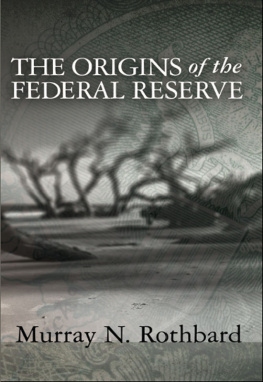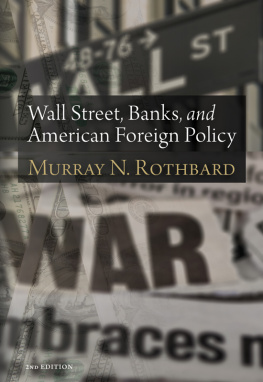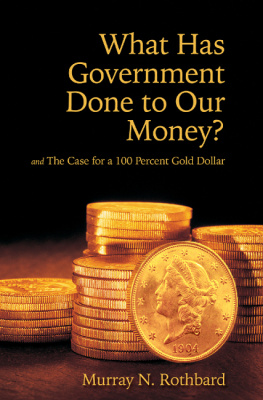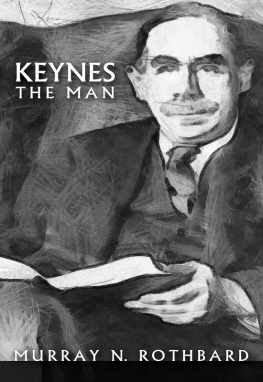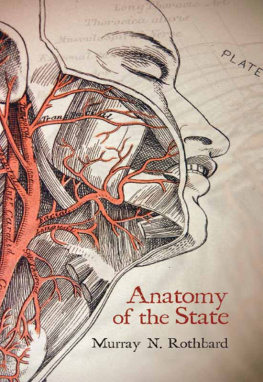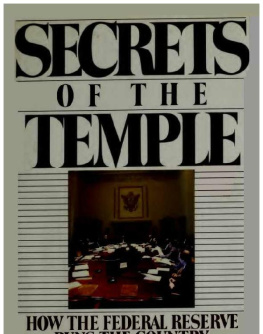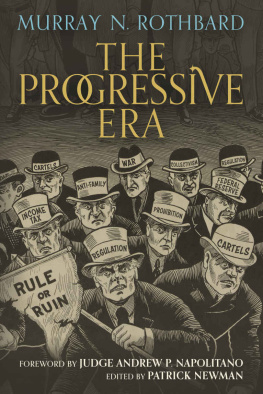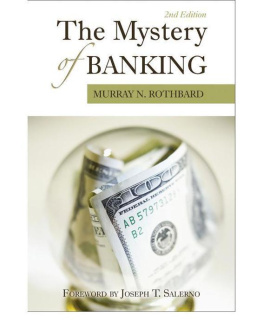Rothbard - The origins of the Federal Reserve
Here you can read online Rothbard - The origins of the Federal Reserve full text of the book (entire story) in english for free. Download pdf and epub, get meaning, cover and reviews about this ebook. City: Auburn, Ala., United States, year: 2009, publisher: Ludwig von Mises Institute, genre: Science. Description of the work, (preface) as well as reviews are available. Best literature library LitArk.com created for fans of good reading and offers a wide selection of genres:
Romance novel
Science fiction
Adventure
Detective
Science
History
Home and family
Prose
Art
Politics
Computer
Non-fiction
Religion
Business
Children
Humor
Choose a favorite category and find really read worthwhile books. Enjoy immersion in the world of imagination, feel the emotions of the characters or learn something new for yourself, make an fascinating discovery.
- Book:The origins of the Federal Reserve
- Author:
- Publisher:Ludwig von Mises Institute
- Genre:
- Year:2009
- City:Auburn, Ala., United States
- Rating:4 / 5
- Favourites:Add to favourites
- Your mark:
- 80
- 1
- 2
- 3
- 4
- 5
The origins of the Federal Reserve: summary, description and annotation
We offer to read an annotation, description, summary or preface (depends on what the author of the book "The origins of the Federal Reserve" wrote himself). If you haven't found the necessary information about the book — write in the comments, we will try to find it.
The origins of the Federal Reserve — read online for free the complete book (whole text) full work
Below is the text of the book, divided by pages. System saving the place of the last page read, allows you to conveniently read the book "The origins of the Federal Reserve" online for free, without having to search again every time where you left off. Put a bookmark, and you can go to the page where you finished reading at any time.
Font size:
Interval:
Bookmark:
THE ORIGINS OF THE
FEDERAL RESERVE
_____ by ______
MURRAY ROTHBARD

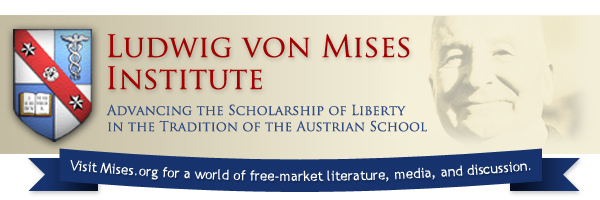
Selected from
A HISTORY OF MONEY AND BANKING IN THE UNITED
STATES: THE COLONIAL ERA TO WORLD WAR II
2009 by the Ludwig von Mises Institute and published under the
Creative Commons Attribution License 3.0.
http://creativecommons.org/licenses/by/3.0/
Ludwig von Mises Institute
518 West Magnolia Avenue
Auburn, Alabama 36832
www.mises.org
ISBN: 978-1-933550-47-3
Contents
The Federal Reserve Act of December 23, 1913, was part and parcel of the wave of Progressive legislation, on local, state, and federal levels of government, that began about 1900. Progressivism was a bipartisan movement which, in the course of the first two decades of the twentieth century, transformed the American economy and society from one of roughly laissez-faire to one of centralized statism.
Until the 1960s, historians had established the myth that Progressivism was a virtual uprising of workers and farmers who, guided by a new generation of altruistic experts and intellectuals, surmounted fierce big business opposition in order to curb, regulate, and control what had been a system of accelerating monopoly in the late nineteenth century. A generation of research and scholarship, however, has now exploded that myth for all parts of the American polity, and it has become all too clear that the truth is the reverse of this well-worn fable. In contrast, what actually happened was that business became increasingly competitive during the late nineteenth century, and that various big-business interests, led by the powerful financial house of J.P. Morgan and Company, had tried desperately to establish successful cartels on the free market. The first wave of such cartels was in the first large-scale business, railroads, and in every case, the attempt to increase profits, by cutting sales with a quota system and thereby to raise prices or rates, collapsed quickly from internal competition within the cartel and from external competition by new competitors eager to undercut the cartel. During the 1890s, in the new field of large-scale industrial corporations, big-business interests tried to establish high prices and reduced production via mergers, and again, in every case, the mergers collapsed from the winds of new competition. In both sets of cartel attempts, J.P. Morgan and Company had taken the lead, and in both sets of cases, the market, hampered though it was by high protective tariff walls, managed to nullify these attempts at voluntary cartelization.
It then became clear to these big-business interests that the only way to establish a cartelized economy, an economy that would ensure their continued economic dominance and high profits, would be to use the powers of government to establish and maintain cartels by coercion. In other words, to transform the economy from roughly laissez-faire to centralized and coordinated statism. But how could the American people, steeped in a long tradition of fierce opposition to government-imposed monopoly, go along with this program? How could the publics consent to the New Order be engineered?
Fortunately for the cartelists, a solution to this vexing problem lay at hand. Monopoly could be put over in the name of opposition to monopoly! In that way, using the rhetoric beloved by Americans, the form of the political economy could be maintained, while the content could be totally reversed. Monopoly had always been defined, in the popular parlance and among economists, as grants of exclusive privilege by the government. It was now simply redefined as big business or business competitive practices, such as price-cutting, so that regulatory commissions, from the Interstate Commerce Commission to the Federal Trade Commission to state insurance commissions, were lobbied for and staffed by big-business men from the regulated industry, all done in the name of curbing big business monopoly on the free market. In that way, the regulatory commissions could subsidize, restrict, and cartelize in the name of opposing monopoly, as well as promoting the general welfare and national security. Once again, it was railroad monopoly that paved the way.
For this intellectual shell game, the cartelists needed the support of the nations intellectuals, the class of professional opinion molders in society. The Morgans needed a smoke screen of ideology, setting forth the rationale and the apologetics for the New Order. Again, fortunately for them, the intellectuals were ready and eager for the new alliance. The enormous growth of intellectuals, academics, social scientists, technocrats, engineers, social workers, physicians, and occupational guilds of all types in the late nineteenth century led most of these groups to organize for a far greater share of the pie than they could possibly achieve on the free market. These intellectuals needed the State to license, restrict, and cartelize their occupations, so as to raise the incomes for the fortunate people already in these fields. In return for their serving as apologists for the new statism, the State was prepared to offer not only cartelized occupations, but also ever increasing and cushier jobs in the bureaucracy to plan and propagandize for the newly statized society. And the intellectuals were ready for it, having learned in graduate schools in Germany the glories of statism and organicist socialism, of a harmonious middle way between dog-eat-dog laissez-faire on the one hand and proletarian Marxism on the other. Instead, big government, staffed by intellectuals and technocrats, steered by big business and aided by unions organizing a subservient labor force, would impose a cooperative commonwealth for the alleged benefit of all.
_____________________________
Originally published as The Origins of the Federal Reserve, Quarterly Journal of Austrian Economics 2, no. 3 (Fall): 351.Ed.
The previous big push for statism in America had occurred during the Civil War, when the virtual one-party Congress after secession of the South emboldened the Republicans to enact their cherished statist program under cover of the war. The alliance of big business and big government with the Republican Party drove through an income tax, heavy excise taxes on such sinful products as tobacco and alcohol, high protective tariffs, and huge land grants and other subsidies to transcontinental railroads. The overbuilding of railroads led directly to Morgans failed attempts at railroad pools, and finally to the creation, promoted by Morgan and Morgan-controlled railroads, of the Interstate Commerce Commission in 1887. The result of that was the long secular decline of the railroads beginning before 1900. The income tax was annulled by Supreme Court action, but was reinstated during the Progressive period.
The most interventionary of the Civil War actions was in the vital field of money and banking. The approach toward hard money and free banking that had been achieved during the 1840s and 1850s was swept away by two pernicious inflationist measures of the wartime Republican administration. One was fiat money greenbacks, which depreciated by half by the middle of the Civil War, and were finally replaced by the gold standard after urgent pressure by hard-money Democrats, but not until 1879, some 14 full years after the end of the war. A second, and more lasting, intervention was the National Banking Acts of 1863, 1864, and 1865, which destroyed the issue of bank notes by state-chartered (or state) banks by a prohibitory tax, and then monopolized the issue of bank notes in the hands of a few large, federally chartered national banks, mainly centered on Wall Street. In a typical cartelization, national banks were compelled by law to accept each others notes and demand deposits at par, negating the process by which the free market had previously been discounting the notes and deposits of shaky and inflationary banks.
Next pageFont size:
Interval:
Bookmark:
Similar books «The origins of the Federal Reserve»
Look at similar books to The origins of the Federal Reserve. We have selected literature similar in name and meaning in the hope of providing readers with more options to find new, interesting, not yet read works.
Discussion, reviews of the book The origins of the Federal Reserve and just readers' own opinions. Leave your comments, write what you think about the work, its meaning or the main characters. Specify what exactly you liked and what you didn't like, and why you think so.

